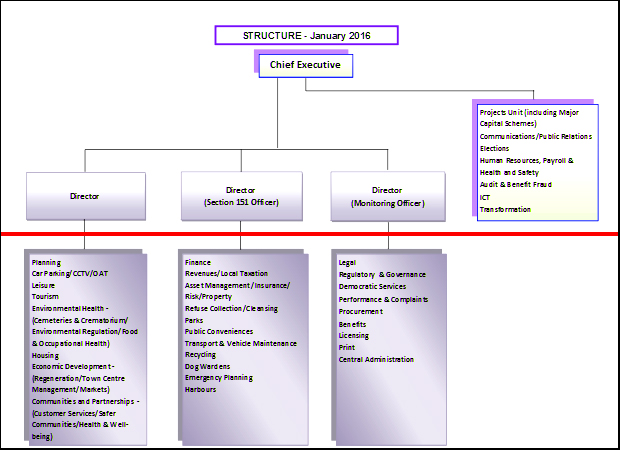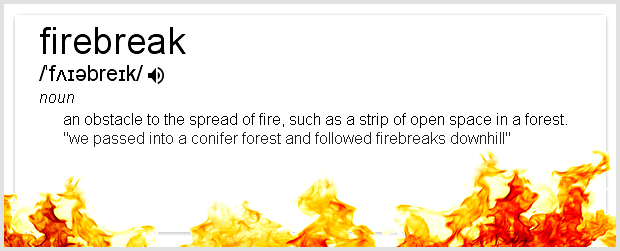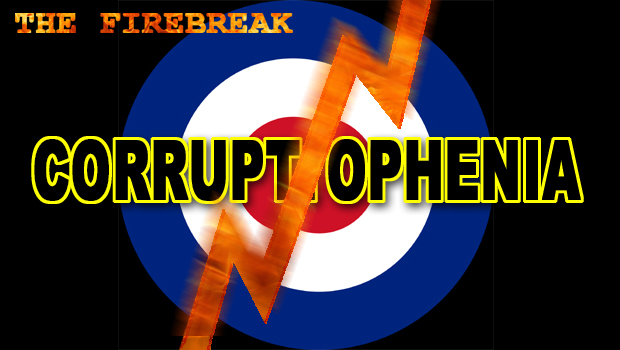Corruptophenia – The Firebreak
- an “In My View” article by NIGEL WARD
~~~~~
Following a widely-spaced series of articles dealing with corrupt practices within local government, and before exposing the precise mechanisms adopted by those directly involved, readers may benefit from reviewing the previous articles in the series:
In every modern corporate organisation, there is a well-documented ‘chain of command’ or hierarchical ‘pyramid’, at the top of which sits the Chief Executive Officer. In the case of District and County Councils, this is the statutory Head of Paid Service.
Typically, the Senior Management structure looks something like this:

Two features of this schematic diagram are noteworthy.
Firstly – and irrespective of the grand job titles accorded to each of the ‘Directors’ – there is the vertical division between service responsibilities, financial responsibilities and legal/regulatory responsibilities.
Secondly, there is the lateral or horizontal separation of the ‘high risk’ faculties over which the Chief Executive has direct oversight, by-passing the mediation of the ‘Directors’ for the key ‘in house’ functions via the Human Resources (HR) department. This facilitates high-level surveillance of every area of staffing – without reference to the individual ‘Directors’ under whose oversight falls the wider spectrum of public services. Specifically, it provides the Chief Executive with a direct oversight over precisely those members of staff who may be presented, perhaps unavoidably, with certain opportunities/temptations to develop schemes to defraud the system.
Together, these divisions form what is known to Common Purpose graduates as a FIREBREAK.
The analogy is obvious – and is represented by the bold red line in the ‘Structure’ graphic, above.

For the purpose of this article, the relevant areas of interest below the red line include Procurement, Assets, Transport and Maintenance. It is not coincidental that these are some of the very same areas that featured so prominently in the infamous High Point Rendel scandal at Scarborough Borough Council (SBC) in 2005.
On that occasion, even the then Chief Exec Mr John TREBBLE found himself in the position of having, euphemistically speaking, to seek early retirement (i.e. resign), even though ‘lesser’ Directors Derek ROWELL (Technical Services), Philip NEWELL (Legal Services) and Trevor TEASDALE (Corporate Services), who had all already fallen foul of the Penn Report (the auditor’s investigation that was for a long time withheld from the public by the Council) had paid the price with their jobs.
The then SBC Leader Councillor Eileen BOSOMWORTH [Con.] also fell on her sword – but not before uttering her by-now infamous epithet, “We will continue to learn lessons” – thus leaving the way clear for a novice Tory Councillor of only two years service to seize power – Councillor Tom FOX [Con.] (former head of Scarborough Police).
And the lessons that Councillor Eileen BOSOMWORTH [Con.] so confidently predicted would be learned have been learned, notably by Councillor Tom FOX [Con.] and by Mr Jim DILLON (who replaced Mr John TREBBLE following the High Point Rendel fiasco) throughout what I will henceforth term ‘the Corruptophenia years’.
The purpose of the FIREBREAK, of course, is to shield Senior Management and leading Councillors from the ultimate responsibility that is their duty to bear, should any fraudulent practice be exposed amongst the lower orders. Everybody below the FIREBREAK is a potential scapegoat – dispensable cannon-fodder in the battle for professional and political survival.
The methodology of the FIREBREAK is simple and requires the application of one golden rule – nothing suspect must ever be committed to the written word; no memos, no minutes, no emails, no letters. The FIREBREAK represents a break in the paper-trail. Authorisation is passed by word of mouth. And there lies the nexus of ‘plausible deniability’.
Consequently, the predominant names emerging from the Employment Tribunal hearing in Hull (1st – 5th August 2016) belong to staff occupying positions below the red line, every one of whom knows to pass the buck downwards – though not all of the intermediaries are necessarily happy about it.
Ms Elaine BLADES (Head of HR) and Mrs Allison JOHNSON (Head of Audit & Internal Fraud), who together appear to have drawn the red line of the FIREBREAK by failing to refer the matter to the senior members of the Irregularity Response Team (IRT) comprising, above the red line, CEO Jim DILLON, s.151 Officer Nick EDWARDS, and Monitoring Officer Mrs Lisa DIXON, the Director of Legal & Democratic Services.
If appearances are anything to go by, Ms BLADES – with her back hard up against the FIREBREAK – is perhaps least delighted with her rôle. Managerial staff below the red line will be quick to realise that they have been hung out to dry.

So it is (necessarily) only the perpetrators of the more paltry frauds – from unauthorised vehicle usage or the selling-off of Council machinery to a new driveway or an upgraded ‘bachelor pad’ – who are called upon to face the music.
In the present case, however, my original source knew far more than “whistleblower” Ben MARRIOTT – and it is this information that will span the FIREBREAK.

There can be little doubt, however damning the evidence presented to the Employment Tribunal by Ben MARRIOTT may have been, that there is a wider picture as yet unknown to him – and as yet unknown to the court.
I hope and expect to be able to publish the full facts once the present court action has run its course – i.e. after 13th December 2016 (when the Remedy Hearing is scheduled to take place) and, hopefully, in time for a Merry Christmas to be had by all.
The Audit Commission has been replaced, since the days of the High Point Rendel scandal, by Public Sector Audit Appointments Limited (PSAA).
The duty to report corrupt and fraudulent activity to the North Yorkshire Police remains with the SBC Monitoring Officer, Mrs Lisa DIXON . . .



























Comments are closed.